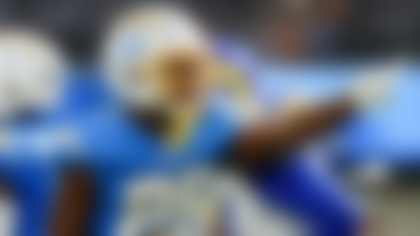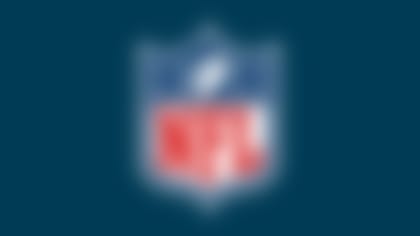NEW YORK -- It was a few minutes before kickoff of the NFL season last Thursday night, and the dimly-lit room described as the "brain" of a game day smelled like coffee.
Al Riveron, who would spend the next three hours standing, sitting, pacing, talking and monitoring infractions small (did that guy run out of bounds and then come back in?) to historic (the first coach's challenge of a pass interference non-call in the regular season), was first presiding over the room's designated snack area, pressing Café Bustelo into a Cuban coffee machine. Aaron Rodgers was about to take the field when Riveron placed a cup -- real china, from the two sets he keeps here -- in front of Dawn Aponte, the league's chief football administrative officer, and the season was on.
Riveron has good reason to act as the host. The Art McNally GameDay Central is the home base of officiating and he is the league's head of officiating. When game announcers say a call is being reviewed in New York, they are talking about this place, a hub of high-definition monitors and headphones at which every game is closely watched. It was Riveron's call when Green Bay Packers coach Matt LaFleur challenged a non-call of offensive pass interference in the fourth quarter against the Chicago Bears (the non-call on the field was upheld -- no flag was thrown) just as it was Riveron's call to allow a staffer to bring his dog when families gathered here while the officiating department was working the Thanksgiving games one year.
Officiating has come under withering scrutiny for years, and their jobs have grown more complex as players have gotten faster and the rules more byzantine. The confluence of high-definition, extremely slow-motion replays available to every viewer with a television or phone and the multiplying effect of social media has elevated what used to be an occasional bad call that would be forgotten in a few hours into full-blown crises that dominate the sports conversation for days.
This season, the league will increasingly do what television networks began doing nearly a decade ago: train a lens on officiating by offering real-time analysis of high profile or complicated calls. The idea behind the league's plan, of course, is not to pile on the scrutiny, but to enlighten fans about how decisions were made, and perhaps to diffuse potential controversies before they gain traction.
"It's what we sign up for," Riveron says of the often critical analysis. "Technology is only going to get better. We have experts on TV that dissect everything we do. At the end, it makes us better. We have to embrace technology even though it picks up things that the human eye might not pick up. Yes, the scrutiny is there, but we have to get better. This game is getting better and if we don't perform at an extremely high level, then the game doesn't go well."
So, barely noticeable, a small camera is mounted on a partition in the officiating lair at the NFL's Park Avenue headquarters, and Riveron's mark on the floor is denoted with a small piece of tape, just a few steps from where he stands at the head of an oblong table to see the games. From that spot, the quick hits -- maybe 10 to 15 seconds long -- Riveron delivers for the department's Twitter feed (@NFLOfficiating) will pull back the curtain a bit on a complex and often confounding element of the game.
"Many have asked why has it taken us so long," said Troy Vincent, the NFL's chief football officer, who oversees the officiating department.
What are they hoping to accomplish? "Just further education, being a little more consistent, not letting something boil to a point where it takes on its own life and it shouldn't," Vincent said. "We should be able to answer that question in the 1 p.m. (ET) window and not wait four or five or six hours later to put out an explanation of why a call was a certain way and why something happened."
The operation is not entirely new. The NFL has provided explanations on television and in videos distributed to media in the last few seasons. And officials still talk to pool reporters after games when necessary, as Riveron did following a time administration error at the end of the first half of the Texans-Saints game Monday night.
But this expanded and more immediate and direct contact with fans feels, inevitably, like a response to the extended firestorm that followed the missed pass interference call in the NFC Championship Game last season, which engulfed the entire bye week leading up to the Super Bowl.
Not so, Vincent said. The NFL had already been contemplating providing more rapid-fire explanations.
"It's necessary for officiating," Vincent said. "It's necessary for the National Football League."
It might be most necessary for the credibility of officials, whose jobs were seemingly made even more difficult this offseason, when, in response to the NFC Championship Game blunder, team owners voted to allow replay review of pass interference, one of the biggest and most fraught penalties in the game.
The demands on officials are well-known to the NFL's Competition Committee, which spends a lot of time worrying about the ever-expanding complexity of the rule book and the unintended consequences new rules create. Until 2014, replay reviews were conducted completely on the field without consultation with the league office. Not until 2017 did authority to make the final decision on reviews shift to New York, in the hopes of making the calls more quickly and making the judgments more consistent. Riveron became an NFL on-field official in 2004 and a referee in 2008 so he knows well the strains on officials.
"You can't blink," he said. "For seven or eight seconds, you blink and you miss it. If you stand back there and blink twice, you will miss that pass or fumble. You don't know if it's a pass or fumble. You have to stay focused for 3 1/2 hours. A lot of our guys and gals don't come off the field physically exhausted but mentally, you're drained. If you don't come off the field mentally drained, you haven't performed your job."
INSIDE THE COMMAND CENTER: 'Even with all the technology, there's imperfection'
It is surprisingly quiet inside GameDay Central on the first Thursday evening of the season. With only one game being played, there are only a dozen or so people here, including the technician sitting at his 58-inch monitor, which can be divided into multiple camera angles. That allows Riveron and the technician to punch up the one that gives Riveron the best view of the play in question. Even this technology has its limits, though. Riveron only has access to the same camera angles the networks have for television. He can't see in-stadium feeds or coaches' tapes. What he sees is the same as what a fan sitting on his or her sofa can see. That means when networks deploy extra cameras for the biggest games, Riveron has more camera shots to peruse before he makes a call.
On a Sunday, this place is jammed, with a technician assigned to each game sitting at his own station and with as many as seven people -- members of the football operations, technology and communications staffs among them -- seated around a huge table that faces the room's dominant feature: three 98-inch, 4K definition televisions, each of which can be divided into four screens. During the early games on a Sunday, those screens can show as many as 12 games at once.
"Even with all the technology, there's imperfection," Vincent said. "There's humans involved and yet we look and seek perfection, oftentimes we fall short of that even in this environment. We're sterile, the latest and greatest technology, we think we can see everything, and sometimes we fall short. We have everything and we still fall short."
There are so many people involved in managing the details of football operations on a Sunday that they occupy four rooms -- a collective command center that Vincent said is the real brain of the NFL. Stephanie Durante, a game operations executive, is in touch with practically everyone at every game site, monitoring, among other things, security threats and the weather, in case lightning forces game operations to order the stands evacuated. Vincent spends Sundays with another staffer next to him, flagging plays for instructional videos -- for officials, for coaches to show what plays and techniques the NFL wants out of the game and for coaches to show what the league likes. He doesn't go to GameDay Central until it is time for the Sunday night game, when some of the crowd dissipates as the earlier games wrap up. There are often former coaches who are between stints on coaching staffs working at least part time in the league office, helping Vincent identify issues with the game, and sometimes spilling secrets about how coaches and players try to circumvent the rules. The presence of those coaches, Vincent thinks, raises the football IQ of those in operations who never played.
It is striking just how much NFL officials are looking for during breaks in game action, and how much they can spot just from the cameras at their disposal. There is one stationary overhead camera shot of the sideline that seems particularly useful. At one point, Vincent spots a man behind one of the team benches sneaking behind the cart of Microsoft tablets to surreptitiously check his cellphone, a no-no on the sideline. Vincent will find out who that person is and if he is allowed to be on his phone (medical and training personnel are).
Aponte notes a player who is not authorized to wear a tinted visor wearing one anyway -- they will call down to tell the team the player can't go back on the field without changing to a clear visor. Vincent is looking for players who are not wearing the required thigh and shoulder pads -- if they don't have them, they will be told to put them on before they return to the field. If the blue tent goes up so a player can be tested for concussion symptoms, the NFL is looking to see if someone on the sideline took the player's helmet so he can't sneak back into the game.
On some overhead shots, Vincent can see what a player is looking at on his tablet. And he is watching to make sure the player swipes his finger up -- the telltale sign he is looking only at the permitted still photos and not at video, which is forbidden. Sideline integrity is an issue Vincent said the NFL has to work on. There are scores of people on a sideline, almost certainly some of them unnecessary. At one point, Vincent is watching on a monitor two security guards who stand just outside the Bears bench area with their backs turned to the field so they can watch fans in the stands. Security guards at those posts sometimes get hurt, because they can't see the game action heading their way until they are rolled over. Vincent said the NFL has to figure out how to better protect them. This game is a relatively quiet one, so there is more time for such observations. Vincent said it is easier to officiate a game in which an elite quarterback -- like Aaron Rodgers -- plays because the quarterback is so efficient. There are fewer incompletions, fewer delays of game, and fewer stoppages of the clock as a result.
For this game, a relative clunker featuring sputtering offenses, Vincent is also fielding texts from former Oakland Raiders coach John Madden, who believes the lack of preseason work by many starters is the reason for the sloppy play.
This room, though, was set up as the nerve center of replay and Riveron is the dominant figure, wearing a small microphone in case he has to quickly tape a Twitter hit. When Green Bay scores the game's only touchdown on a short Rodgers pass to Jimmy Graham early in the second quarter, Riveron goes to the monitor for the requisite review of all scoring plays.
"Confirmed," he tells the monitor, who relays the message to the replay official at Soldier Field. And Riveron returns to his perch at the head of the table. On the very next offensive play, Mitchell Trubisky heaves a 27-yard pass down the left side to Allen Robinson. Riveron goes back to the monitor to make sure it was really a catch. It is. He goes back to his spot.
One of the biggest misconceptions about officiating, Riveron said, is that the officiating crew flies into town on Saturday evening, has a nice dinner, calls the game and then leaves. That is all true, but if the crew flies out Sunday night, they are greeted by five or six training videos on their computers sent from the command center that they watch on the flight home. Most crews have conference calls during the week to go over what happened in the game they just finished and the one they will have the next weekend. There are six officiating supervisors -- one for each position of the crew -- who analyze performance and frequently talk to crew members. Riveron talks to crews himself, especially if there was an officiating issue.
During the game, though, it is almost always silence. There is no in-game direction if a call is missed, no instruction to throw fewer flags if a game is bogged down.
"I can tell you as an ex-official, I don't want anybody talking to me," Riveron said. "I want to be able to do my job, to concentrate and let's play football. The only time we communicate is during the game when we have a replay review."
Finally, early in the fourth quarter, the NFL got the moment it had long braced for. After a Trubisky completion, LaFleur threw a challenge flag, wanting the play reviewed to see if receiver Taylor Gabriel's apparent push-off against cornerback Jaire Alexander should have been penalized for offensive pass interference.
Riveron went over to the monitor, put on the headset and told the replay official at Soldier Field to let him know when referee Tony Corrente was ready. On the television broadcast, Al Michaels said "If that's clear and obvious, I'm an astronaut."
"Tony, you there?" Riveron asked, as he started punching up different camera angles.
"Calm down, it's early," Riveron said, almost to himself, as he kept looking for the right shot.
In the meantime, Michaels was reviewing the preseason statistics on pass interference challenges, when the NFL made clear it would be very difficult to get a call on the field overturned.
Riveron, still on the headset with Corrente and the replay official in Chicago, had seen enough. The goal is to finish reviews in less than a minute. He saw what LaFleur later admitted he realized almost immediately after he threw the flag: there wasn't anything close to clear and obvious evidence to change the non-call on the field.
"We're going to let this stand, guys," Riveron said. "Charge him with the timeout. Thanks, guys."
The NFL had gotten through the first of what even Vincent anticipates will be the most difficult rule to officiate this season. Then came the real surprise.
"I'm amazed at the number of calls officials get right," Cris Collinsworth said on the broadcast. That elicited a collective "Whoa!" in GameDay Central.
A few minutes later, Riveron decided to do a written tweet to explain why offensive pass interference was called on another play and why it was the correct call.
At the two-minute warning, Riveron stands up and goes to the monitor. All reviews are initiated by the replay official in the booth in the final two minutes, and these were the minutes that gave everyone in the NFL the most pause about the pass interference challenge rule. Would the replay officials stop the games too often?
"Inside of two minutes, that action is moving fast," Riveron said. "If it's not a stopped clock, and we have a 14-yard gain, we might only have one look at it, which is the line feed and then another look with the naked eye. If nothing pops up, if it's not clear and obvious, we're playing football."
There would not be much more football that night. With little over a minute left in the game, Trubisky is sacked on fourth down.
Riveron takes off his headset.
"OK, we're going home."
Follow Judy Battista on Twitter @judybattista.




